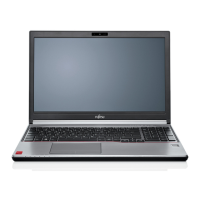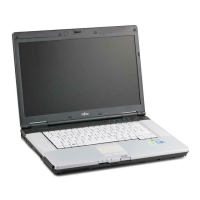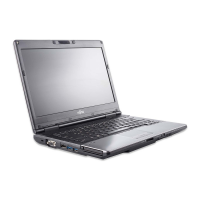How to correct the date and time on a Fujitsu Laptop?
- TTammie MackSep 2, 2025
You can set the date and time on your Fujitsu Laptop using the BIOS-Setup-Utility in the main menu.

How to correct the date and time on a Fujitsu Laptop?
You can set the date and time on your Fujitsu Laptop using the BIOS-Setup-Utility in the main menu.
Why only numerals are written when typing on Fujitsu lifebook e736?
If when certain characters are entered on the keyboard of your Fujitsu Laptop, only numerals are written, it indicates that the virtual numeric keypad is activated. Press the Num key to deactivate it.
Why is the LCD screen difficult to read on my Fujitsu lifebook e736 Laptop?
If the LCD screen on your Fujitsu Laptop is difficult to read, it may be due to reflected glare. Try turning the notebook or adjusting the tilt of the LCD screen. Alternatively, increase the brightness of the screen.
What does 'Press to resume, to SETUP' mean on Fujitsu lifebook e736?
If your Fujitsu Laptop displays the message 'Press to resume, to SETUP', it indicates an error occurred during the self-test before starting the operating system. Press the F1 function key to start the operating system, or press the F2 key to access the BIOS Setup.
How to resolve Failure Fixed Disk error on Fujitsu Laptop?
If you encounter a 'Failure Fixed Disk n' error on your Fujitsu Laptop, it means the settings of the hard disk drive are incorrect. Start the BIOS Setup (Primary Master submenu) and select the correct settings.
What does 'nn Stuck key' mean on Fujitsu lifebook e736?
If your Fujitsu Laptop displays 'nn Stuck key', make sure that no key is pressed.
What to do if Fujitsu lifebook e736 Laptop LCD screen remains blank?
If your Fujitsu Laptop screen remains blank, try pressing a key or touching the touchpad. If you have an external monitor or television connected, press the key combination to switch the screen output.
What to do if the notebook’s LCD screen remains blank on Fujitsu lifebook e736 Laptop?
If the LCD screen of your Fujitsu Laptop remains blank, press a key or touch the touchpad to see if the monitor is switched off. If you have an external monitor or television set connected, press the key combination to switch the screen output.
What to do if external monitor is blank or the image is unstable on Fujitsu lifebook e736?
If the external monitor is blank or the image is unstable on your Fujitsu Laptop, terminate the application program in Windows by pressing Alt + F4. Set the screen resolution as described in the documentation for your operating system. Select monitor 1 or 2 as described in the documentation for your operating system.
What to do if external monitor is blank on Fujitsu lifebook e736?
If your external monitor remains blank, first ensure it is switched on. If it is on, check if power saving mode has been activated by pressing any key. Adjust the monitor's brightness if it is set too low. Verify that the screen output is correctly set and the power and data cables are properly connected to both the notebook and the monitor. After checking the connections, switch on the external monitor and the notebook.
| Bus type | OPI |
|---|---|
| Stepping | D1 |
| Tjunction | 100 °C |
| Processor cache | 4 MB |
| Processor cores | 2 |
| Processor model | i7-6500U |
| System bus rate | 4 GT/s |
| Processor family | Intel® Core™ i7 |
| Processor series | Intel Core i7-6500 Mobile series |
| Processor socket | LGA 1356 (Socket B2) |
| Processor threads | 4 |
| Processor codename | Skylake |
| Configurable TDP-up | 25 W |
| Processor frequency | 2.5 GHz |
| Processor cache type | Smart Cache |
| Configurable TDP-down | 7.5 W |
| Processor lithography | 14 nm |
| Processor manufacturer | Intel |
| Processor front side bus | - MHz |
| PCI Express slots version | 3.0 |
| Processor boost frequency | 3.1 GHz |
| Processor operating modes | 64-bit |
| ECC supported by processor | No |
| PCI Express configurations | 1x4, 4x1 |
| Thermal Design Power (TDP) | 15 W |
| Configurable TDP-up frequency | 2.6 GHz |
| Configurable TDP-down frequency | 0.8 GHz |
| Maximum number of PCI Express lanes | 12 |
| On-board graphics card | Yes |
| On-board graphics card ID | 1916 |
| Discrete graphics card model | Not available |
| On-board graphics card model | Intel® HD Graphics 520 |
| Maximum on-board graphics card memory | 1.74 GB |
| On-board graphics card OpenGL version | 4.4 |
| On-board graphics card base frequency | 300 MHz |
| On-board graphics card DirectX version | 12.0 |
| On-board graphics card dynamic frequency (max) | 1050 MHz |
| Form factor | Clamshell |
| Product type | Laptop |
| Product color | Gray |
| Memory slots | 2x SO-DIMM |
| Internal memory | 8 GB |
| Memory clock speed | 2133 MHz |
| Memory form factor | SO-DIMM |
| Internal memory type | DDR4-SDRAM |
| Maximum internal memory | 32 GB |
| SSD capacity | The Solid State Drive's storage capacity in Gigabytes. |
| SSD interface | SATA III |
| Storage media | SSD |
| SSD form factor | 2.5\ |
| Total storage capacity | 512 GB |
| Compatible memory cards | SD, SDHC, SDXC |
| Number of SSDs installed | 1 |
| Display surface | Matt |
| Display diagonal | 13.3 \ |
| Display brightness | 330 cd/m² |
| Contrast ratio (typical) | 1000:1 |
| Audio chip | Realtek ALC255 |
| Front camera resolution (numeric) | 2 MP |
| 4G standard | LTE |
| 3G standards | HSPA+, UMTS |
| Wi-Fi standards | Wi-Fi 5 (802.11ac) |
| Bluetooth version | 4.1 |
| Ethernet LAN data rates | 10, 100, 1000 Mbit/s |
| Mobile network generation | 4G |
| Charging port type | DC-in jack |
| USB 2.0 ports quantity | 0 |
| USB 3.2 Gen 1 (3.1 Gen 1) Type-A ports quantity | 3 |
| Pointing device | Touchpad |
| Keyboard number of keys | 85 |
| Battery capacity | 6700 mAh |
| Battery life (max) | 14 h |
| Battery recharge time | 3 h |
| Number of battery cells | 6 |
| AC adapter power | 65 W |
| AC adapter frequency | 50 - 60 Hz |
| AC adapter input voltage | 100 - 240 V |
| AC adapter output current | 3.42 A |
| AC adapter output voltage | 19 V |
| Cable lock slot type | Kensington |
| Password protection type | BIOS, HDD, Supervisor, User |
| Operating temperature (T-T) | 5 - 35 °C |
| Operating relative humidity (H-H) | 20 - 80 % |
| Sustainability certificates | RoHS, EPEAT Gold, ENERGY STAR |
| Certification | CE, CB, WEEE, Microsoft Operating Systems (HCT / HCL entry / WHQL) |
| Processor code | SR2EZ |
| Processor ARK ID | 88194 |
| Processor package size | 42 X 24 mm |
| Supported instruction sets | SSE4.1, SSE4.2, AVX 2.0 |
| Intel Secure Key Technology version | 1.00 |
| Intel Stable Image Platform Program (SIPP) version | 0.00 |
| Depth | 228 mm |
|---|---|
| Width | 321 mm |
| Weight | 1600 g |
| Height (rear) | 27 mm |
| Height (front) | 20 mm |
Details FCC compliance for the Fujitsu LIFEBOOK E736, E746, and E756 models.
Information on how to contact Fujitsu for service and support, including phone and website.
Explains warning symbols, information symbols, and text styles used in the manual.
Diagrams and labels for port and control views across LIFEBOOK models.
Essential safety information, handling guidelines, and precautions for notebook operation.
Instructions on how to connect the AC adapter to the notebook and power outlet.
Explanation of the various status indicators on the notebook for power, drives, and keyboard functions.
Details the functions of various keys, including Backspace and Tab keys.
Illustrates the layout of the virtual numeric keypad and how to use it with Num Lock.
Lists common Fn key combinations for controlling backlight, speakers, and touchpad.
Instructions on moving the mouse pointer and selecting items using the touchpad.
Information about the LCD backlight and how to adjust brightness.
Details on how to use the integrated webcam for pictures, video, and web chats.
Guidelines for charging, storing, and maintaining the notebook's battery for optimal life.
Lists available modular bay devices and provides guidelines for their use and hot-swapping.
Guidelines for safely handling and storing optical discs.
Procedure for manually ejecting the optical disc drive tray in case of power failure.
Instructions for removing and cleaning the dust filter for optimal cooling.
How to utilize power-management features in Windows for energy efficiency.
Instructions for inserting and removing Secure Digital (SD) memory cards.
Information on speaker/microphone placement and volume control via key combinations.
Procedure for enabling or disabling wireless LAN and Bluetooth using the WirelessSelector.
Instructions for connecting the notebook to a local area network using the LAN port.
Diagram identifying all ports and connectors on the Fujitsu Port Replicator.
Table showing supported monitor configurations with LIFEBOOK and Port Replicator ports.
Step-by-step guide on how to connect the notebook to the Port Replicator.
Instructions for safely disconnecting the notebook from the Port Replicator.
Instructions for setting up supervisor and user HDD passwords in the BIOS for data security.
Procedure to remove supervisor and user HDD passwords from the BIOS Setup Utility.
How to enable or disable password protection for the operating system boot process.
Instructions for activating and deactivating the Trusted Platform Module (TPM) via BIOS Setup.
Instructions on how to correctly insert a SmartCard into the reader.
Details on connecting analogue VGA, digital DisplayPort, and DVI-D monitor ports.
Instructions for connecting the notebook's HDMI port to external devices like TVs or amplifiers.
Information on connecting USB devices, data transfer rates, and automatic driver installation.
Details on using the USB port for charging devices, including power supply recommendations.
Steps for safely removing USB devices to prevent data loss.
Instructions for connecting external microphones or audio input devices.
Important notes and precautions regarding static discharge (ESD) and handling components.
Guidelines for installing memory expansion modules, including warnings about heat and static electricity.
Detailed steps for safely removing the hard disk drive from its compartment.
Detailed steps for safely installing the hard disk drive into its compartment.
Procedure for accessing and starting the BIOS Setup Utility.
Option to save changes and exit the BIOS Setup Utility.
Guidance on what to do when encountering unresolved computer problems.
Troubleshooting steps for blank or difficult-to-read LCD screen issues.
Troubleshooting steps for when the external monitor image is blank or unstable.
Troubleshooting steps for when the notebook fails to power on or start.
Troubleshooting steps for issues with wireless network connectivity.
Explanation and resolution for common BIOS error messages encountered during startup.
Technical specifications for LIFEBOOK E736, E746, and E756 models, including dimensions.
Information on proper disposal and recycling of the notebook and its battery.
Information regarding FCC regulations, including notices to users of radios and televisions.
Crucial safety instructions for operating the notebook and its AC adapter.
Details on FCC compliance limits for Class B digital devices and potential interference.
Information on the benefits of ENERGY STAR compliance for energy efficiency and environmental protection.
Guidelines for using the optional Wireless LAN device, including characteristics and modes.
Instructions for creating DVD copies of Recovery Image and Bootable Disc for Windows 7.
Steps to restore the recovery image for a full hard disk recovery on Windows 7.
Table outlining recovery options like System Restore, Reset PC, and Reinstall Windows.
Detailed steps for creating a recovery drive using a USB flash drive in Windows 10.
Details on 'Keep my files' and 'Remove everything' options for resetting Windows 10.
Instructions on how to use FSDM to download the latest drivers and utilities for the system.










